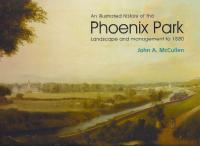An illustrated history of the Phoenix Park: landscape and management to 1880 John A. McCullen (Office of Public Works, Ä40) ISBN 9781406424256
Published in 18th–19th - Century History, Book Reviews, Early Modern History (1500–1700), Issue 6 (Nov/Dec 2010), Reviews, Volume 18 John A. McCullen’s Illustrated history of the Phoenix Park does exactly what it says on the tin. A detailed description and time-line of the landscape management and design of Dublin’s Phoenix Park, it is published in a lavish large-format volume, and gorgeously illustrated with over 240 maps, plans and full-page colour prints. McCullen is chief park superintendent, and the book draws on recent research on the landscape and architectural history of Phoenix Park, including hitherto unpublished sources from the archives of the Office of Public Works and the State Art Collection.
John A. McCullen’s Illustrated history of the Phoenix Park does exactly what it says on the tin. A detailed description and time-line of the landscape management and design of Dublin’s Phoenix Park, it is published in a lavish large-format volume, and gorgeously illustrated with over 240 maps, plans and full-page colour prints. McCullen is chief park superintendent, and the book draws on recent research on the landscape and architectural history of Phoenix Park, including hitherto unpublished sources from the archives of the Office of Public Works and the State Art Collection.
The History is divided into seven chapters, focusing primarily on the period 1800–80. McCullen opens, however, with a lengthy chronicle-like history of the park from Bronze Age settlement up to 1662, when James, duke of Ormond, the new lord lieutenant, arrived in Ireland following the Restoration and began accumulating lands and constructing the boundaries of the royal deer-park that would eventually become Phoenix Park as we know it today.
What strikes one most when reading McCullen’s history is the sheer enormity of Phoenix Park as an administrative and cultural entity. Even its expanse is exceptional: with a surface area of 1,752 acres, it is larger than London’s Hyde Park, Regent’s Park, Kensington Gardens, St James’ Park, Green Park, Greenwich and Battersea Parks all put together. Meanwhile, from the point of view of park management, the period that McCullen covers was one of massive infrastructural development, which saw major changes not only to the park’s architecture and visual aspect but also to the administrative policy governing its institutional and recreational use.
In treating this historical evolution, the author takes a theme-based approach to his material, and remaining chapters of the book examine park management structures; finance; infrastructure; the design and development of the park’s public landscape; the history of the demesnes of the lord lieutenant, chief secretary and under-secretary of Ireland; and a constellation of secondary lodges, military fortifications and institutions, not forgetting Dublin Zoo. Peopled by an army of bailiffs, keepers, architects, accountants and workmen, the present-day park comes into shape before our eyes.
In fact, the chief lesson of McCullen’s study is precisely that the park landscape we have inherited today largely devolves from work carried out in 1800–80, with the hub of structural activity taking place between 1832 and 1849, as substantial money was made available for improvements under the care of the landscape architect Decimus Burton. Park perimeters were redefined, the land was fenced, drained and planted, gate-lodges were rebuilt to a classical design and a road network was laid out, radiating from the new Grand Avenue, ‘by which a noble vista [was] obtained’.
As the more picturesque landscape was moulded into place, the management began to discourage undue military use of Phoenix Park in favour of public recreation. The Promenade Grounds (1844), later the People’s Gardens (1868), were created; games were introduced, with the polo grounds established in 1874; and the right to hold public meetings was granted. A Fenian Amnesty Meeting drew 60,000 attendants in September 1871, although the park also saw more prosaic protests, as on Sunday 20 May 1875, when 7,000 members of the Dublin Total Abstinence League met in the Hollow opposite Dublin Zoo to manifest support of Sunday closing, while, simultaneously, a separate group thronged to the Wellington monument to demonstrate against it.
Although McCullen’s focus remains the objective, material landscape, these sketches of park life make up a great part of the book’s charm for the general reader. Likewise, because the material is principally analysed from the point of view of management and garden design, it does not provide an account of the historical context in which park development took place, nor of the political motives behind nineteenth-century park management.
Phoenix Park was the only royal park in Ireland at the time, and for over half of the century its public areas were managed directly from London. It was also the site of residence of the chief government officials, as well as military apparatus such as Mountjoy Barracks and the Magazine Fort, the distribution centre for powder and munitions to the Dublin barracks. It is regrettable, then, that McCullen offers no analysis of the role of architecture and aesthetic landscaping either in symbolically representing the authority of the British state or in giving visual presence to post-Union British culture in Ireland. (For this material readers would be advised to look to Dana Arnold’s excellent article in Cultural identities and the aesthetics of Britishness (Manchester, 2004)).
Nonetheless, as an informed and meticulous study of the construction of a national institution, the Illustrated history maintains a strong claim on our attention. The real wealth of the book lies in its stunning collection of prints, architectural drawings, maps and surveys, which effectively form a photo-essay in their own right, visually documenting the transformation of Phoenix Park over the centuries. It is impossible to close this review without stressing what a beautiful, even rare, volume this is: midway between a specialised landscape history and a coffee-table book, it will tempt a wider than expected audience of readers. HI
Ciara Hogan is a postgraduate student at Université Paris Descartes.
'
















